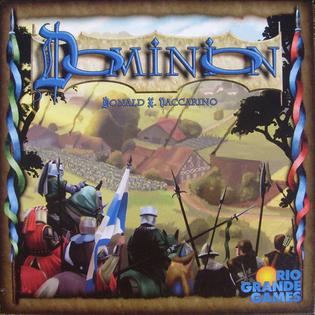Summary
Number of players: 2-4
Ages: 8+
Length: 30 minutes
Dominion is a deck-building card game, where you take on the role of a monarch competing to build the best Dominion.
Your dominion is represented by your deck of cards which you build by purchasing cards from a shared supply. The best dominion is determined by the player with the most victory points at the end of the game.
Your dominion starts out as a small sad collection of Estates and Coppers, but you hope by the end of the game it will be brimming with Gold, Provinces, and the inhabitants and structures of your castle and kingdom.
There are four main types of cards:
- Victory cards, which have a Victory Point value that is tallied at the end of the game to determine the winner, but generally have no value during the game.
- Curse cards, which are like Victory cards, but have a negative Victory Point value that counts against the player at the end of the game.
- Treasure cards, played during the Buy Phase, which generate Coins (and sometimes have other effects).
- Action cards generate effects during a player's turn, allowing that player to gain more cards, Coins, Buys, or Actions, to get rid of cards, or they may affect other players in the game.
Setup
In the centre of the table is a shared supply consisting of Treasure (Copper, Silver, Gold), Victory (Estate, Duchy, Province), Curses, 10 Kingdom cards, and a trash pile. Each player is dealt 7 coppers and 3 estates which are shuffled to form the player's starting deck. Then each player draws 5 cards to create their starting hand.
How to Play
Players take turns in clockwise order. With each turn consisting of three phases:
- Action phase: The player starts with 1 Action during this phase, with which they may play one Action card, following its instructions. As some Action cards generate additional Actions, the player may be able to chain many Action cards together to generate Coins, Buys, or other benefits. Remaining Actions do not carry over into the next turn.
- Buy phase: The player starts with 1 Buy during this phase, plus any extra Buys generated during the Action phase. To pay for cards, the player can use any Treasure cards in their hand to generate Coins, as well as any Coins earned during the Action phase. The player can buy a number of cards from the table up to the number of Buys they have; all cards have a price in Coins noted in the bottom left of each card. Bought cards are added to the player's discard pile (from which they will later be shuffled into the player's deck). The player does not need to use all of their Buys nor spend all of their Coins, but unused Buys and Coins do not carry over into the next turn.
- Cleanup phase: The player collects their hand and all played cards and places those into their discard pile. The player then draws five new cards from their deck.
If at any time the player must draw a card from their deck, but their deck is empty, they shuffle their existing discard pile and use it as their new deck.
The game ends under two conditions: when the stack of Province cards (the highest-value Victory card in the base game) has been exhausted, or when any three other stacks in the Supply have been exhausted. At that time, the players count the number of Victory Points in their complete decks, and the player with the highest score is the winner.
Usually the main strategy is to strive to build a deck that maximizes the ability to draw hands that provide 8 coins, which then allows the purchase of a Province card - the highest value Victory card in the base game. Since the victory cards have no value during the game (and therefore clog up draws), players must balance building the deck to reach the 8 coin goal with the acquisition of victory cards to win the game.
Review
The base game comes with 25 kingdom cards of which only 10 are used in any given game. So there are 3,268,760 combinations of kingdom cards :O. This provides great re-playability as the best path to victory changes with each different set of kingdom cards.
 |
The game is incredible fun trying to work out card combos and the best way to collect the most victory points before the game ends. At times the game can feel a bit like multi-player solitaire when there are no attack cards, but you still racing the other players to victory and there is a limited number of each kingdom card that is being competed for.
I have found the game very easy to teach (the ABC phases of the turn) and have found it only takes one game with a could of helpful tips and hints before the new player has a grasp on the game. As such I would highly recommend this game as a gateway game.
After players have a hang on the mechanics the game plays very quick and usually play multiple games back to back. This game has quickly become a favourite of mine and I'll be looking to add some of the many expansions released to this beautiful game.
Rating: 5 out of 5.



